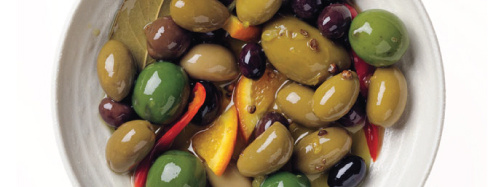Our Top 10 of delicious and more unusual olive varieties
As we’ve previously discussed, when it comes to olives, our culinary tastes in the UK have developed radically over the past decades, and today you don’t need to find a specialist delicatessen to discover exciting olive varieties - as even major supermarkets now compete to offer something new.
However, beyond the jumbo Gordals, acid green Nocellaras and ubiquitous Spanish Manzanillas, importers and connoisseurs of this bitter fruit can offer some even more exciting and unusual olive options.
So enjoy our Top 10 recommendations below, and drop us a line to discuss all your olive requirements and queries.
1: Agrinion
Cultivated in the Agrinion region of Greece around the sea to the west of the country, you may not have heard of this variety, even though they are the most popular in Greece after the world renown Kalamata. Agrinion olives are the medium to large fruit of the Conservolea tree, one of the oldest olive trees in the world. Although they often sell as light green olives, they come in all shapes and sizes, and are available in both green and black form. These particular olives have a fruity and tangy taste, along with a firm outer bite but a very soft texture.
2: Alfonso
While Alfonso olives are traditionally considered Chilean, the province of Tacna, in the foothills of the La Yarada mountains, where they originated, has been under Peruvian rule since 1929. Alfonso olives are visually appealing, with an intense purple hue, which is enhanced by producers who traditionally brine cure them in a mixture of red wine and vinegar, giving them a satisfyingly sharp and tangy taste along with a soft, juicy texture. Ideal served with charcuterie and strong-flavoured hard cheeses.
3: Beldi
Beldi are a small and fruity olive hailing from Morocco. Olive farmers harvest fully matured Beldi late in the season when they offer a rich and intense taste. Following this, the olives are dry-cured with salt and then packed in oil (the traditional Moroccan preserving method), which also imbues them with a soft and chewy texture similar to other sun-dried fruits such as tomatoes and prunes, and a deep, strong flavour. They’re a great addition to traditional Morrocan dishes such as tagines, as well as a fine accompaniment to cheese.
4: Cordovil
From the Casteloc Branco region of the Portuguese interior, Cordovil olives are one of the world’s oldest cultivars, and not only do they produce sought after premium oil, with lush grassy notes, but they also make delicious table olives. Harvested during early winter (normally during November) Cordovil olives themselves are of medium size with a greenish-yellow tinge and a complex flavour that’s deep and fruity while also delivering subtle, slightly spicy bitterness.
5: Gemlik
Gemlik olives are a cultivar that from Turkey, growing in the Zeytinbagi region in the country’s north. Here in the Marmara Sea area the conditions and climate for olive growing are considered ideal; consisting of both high summer temperatures and cold winters. The medium-sized, jet-black Gemlik are predominantly grown as table olives, cured only in oil to accentuate their naturally deep and satisfying flavour. These are some of the best tasting olives in Europe.
6: Leccino
One of the primary cultivars used in the production of Italian olive oil, Leccino olives originate from Tuscany, and although they are grown across the world these days they are easily recognisable by their singular, hazelnut brown skins. As a pleasingly appropriate complement, Leccino olives are also nutty in flavour, with a taste that’s light, refreshing and slightly sweet and spicy. Thanks to this, Leccino are usually cured in plain brine, so as not to interfere with there natural complexity.
7: Lugano
Often mistaken for an Italian variety, Lugano olives (unlikely as it may seem) are actually from Switzerland, where they are grown in the mild microclimate around the shores of Lake Lugano, located in the Italian-speaking Ticino region. Growers harvest these Swiss olives when they are fully ripe, giving them a deep black colour. The olives are a medium size with a firm texture, and the taste is slightly bitter and delicately salty. They are most often used as a hors d'oeuvre or as a complement to salads and pasta.
8: Mission
An olive variety that actually comes from the United States, as it’s name might suggest, the Mission olive is a cultivar developed by Spanish missionaries in the late 18th century. These early Franciscan monks took advantage of the sunny climes of the El Camino Real in California to grow these small green olives that are resistant to both cold and bruising, making oil as well as black oil-cured and green brine-cured table olives that are mild, grassy, and bright in flavour.
9: Nyon
Mention French olives and many will immediately think of Nicoise, however this is actually a type of preparation (using oil and herbs) given to olives that are almost identical to the Italian Ligurian variety. Nyon olives however, are authentically French. Originating from Nyons, they are a product of the Tanche tree, which is the most productive (and famed) French variety. Small and black in colour, the olives are usually either dry-cured or cured in oil and deliver a mild, bitter but enjoyable flavor along with a very soft and chewy texture.
10: Verdail
Hailing from the sun-drenched south of Spain, Verdial olives are grown predominantly in the Velez-Malaga region, and if you’re a fan of the Scicilian Nocellara olives that gained so much popularity in the UK over the last few years but you’re ready for a slight change, then Verdail are your answer. The same distinctive shade of apple green as Nocellara and with similarly firm flesh and medium buttery texture, Verdail deliver a crisp, clean fruity taste that has long made them a Spanish favourite.
